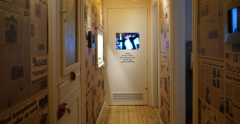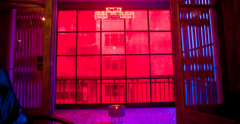
23.5 Hrant Dink Site of Memory opened its doors to visitors in three languages on 17 June 2019, after its pre-opening on April 23, 2019. It aims to continue Hrant Dink's dreams, values, struggles, and words with the exhibitions, which aim to shed light on the recent history of Turkey through important events in Hrant Dink's life.
The Sebat Building on Halaskargazi Avenue, in the Osmanbey neighborhood of Istanbul, was constructed in the mid-1920s by architect Rafael Alguadiş.
In 1999 the Agos newspaper, which had been founded by Hrant Dink and a group of friends in 1996, moved its offices to the Sebat Building. The paper’s mission was to draw attention to and raise awareness about the problems of Armenians and other minorities, to inform the public about Armenian culture and minority cultures, to shed light on the past, and to contribute to Turkey’s democratization. With content in Turkish and Armenian, Agos quickly became an influential news outlet.
On 19 January 2007, Hrant Dink was assassinated in front of the Sebat Building. Hundreds of thousands attended his funeral ceremony, earning the Agos office and the Sebat Building a place in the collective memory and public conscience. Every year on January 19, thousands of people gather in front of the Sebat Building to commemorate Hrant Dink and to demand justice.
In 2015, the Agos Newspaper and Hrant Dink Foundation moved from the Sebat Building to new premises. Given the symbolic significance of the site and its place in the collective memory, a decision was taken to turn the former office into a site of memory. After four years of preparations, the site of memory was opened to the public.
For detailed information on the preparatory phase: Twenty Three and a Half Hrant Dink Site of Memory, Preparatory Phase Report
Vision and Mission
The site of memory takes its name from the article “23.5 April”, written by Hrant Dink and published in Agos on April 23, 1996. The 23.5 Hrant Dink Site of Memory is a space that addresses and highlights the importance of the universal values embraced and championed by Hrant Dink — such as democracy, equality, justice, human rights, and freedoms — as well as building a bridge between memory and hope.
The 23.5 Hrant Dink Site of Memory aims to serve as a space for dialogue, production, research, sharing, and contemplation that
✔sheds light on the past while also taking action for the future;
✔fosters empathy, mutual understanding and democratization;
✔develops responses to societal issues;
✔encourages individuals to act for a future in which democracy and peace prevail;
✔provokes questions while providing access to information;
✔contributes to social transformation through visitor and education programs.
23.5 Sections
As Hrant Dink guides you through the site, you will bear witness to his life, his work as a rights defender, and his death, while also seeing snapshots of different historical periods in Turkey.
Hrant Dink’s Office has been kept as it was, while in other rooms visitors are invited to question and discuss notions such as identity, equality, truth, and justice through texts, videos, and installations.
23,5 Hrant Dink Site of Memory Rooms
Atlantis Civilization
https://hrantdink.org/images/hafizamekani/235hafizamekani/Atlantis-770-400.png
Agos Room
https://hrantdink.org/images/hafizamekani/235hafizamekani/Agos770400.png
The Quest for Justice
https://hrantdink.org/images/hafizamekani/235hafizamekani/Adalet77400.png
The Multi-Purpose Event Space
https://hrantdink.org/images/hafizamekani/235hafizamekani/noda770400.png
Corridor
https://hrantdink.org/images/hafizamekani/235hafizamekani/Koridor770400.png
Salt and Light
https://hrantdink.org/images/hafizamekani/235hafizamekani/Tuzsik770400.png
The Multi-Purpose Event Space: In line with 23.5’s mission to be a site of sharing, production, reflection, and research, this space hosts a range of workshops and events. In addition, visitors have the opportunity to explore different aspects of Hrant Dink's life through video walls consisting of documents, photographs, and videos. In this space, researchers and visitors also have access to ten years of the Agos archives, dating from 1996-2007.
Corridor displays events from the history of Turkey from 1996-2007, accompanied by news stories and headlines that appeared in Agos. The exhibits focus on significant developments for minorities and events that hold a powerful place in the collective memory.
Tırttava is designed to highlight the discrimination Hrant Dink faced during his military service, this room offers a space for visitors to tell their own stories through video recordings or written accounts, and to view the stories shared by others.
Toilet Choir installation addresses the antidemocratic acts of the 1980 military coup through Hrant Dink’s own experience of being subject to psychological and physical torture in a cell converted from a toilet while under arrest after the coup.
Agos Room uses first-hand accounts, newspaper archives, drawings, photos, and videos to tell the story of the establishment of Agos, its achievements, the topics it has covered and the impact it has had.
Atlantis Civilization Room focuses on Hrant Dink’s childhood years in Camp Armen in Tuzla, his struggle, and the story of Hrant and Rakel Dink. The space also calls attention to the cultural heritage of non-Muslim communities in Turkey and addresses the problem of property confiscated from minority foundations.
The Dovelike Disquiet Room offers visitors an insight into how Hrant Dink became targeted after 2004. The trials and protests against Hrant Dink and Agos are displayed in chronological order through Hrant Dink’s own narratives, accompanied by videos, news reports, documents, and articles.
The Quest for Justice room features videos, documents, and first-hand accounts to shed light on the events of January 19, on the ongoing Hrant Dink murder trial, on the commemorations held every year on January 19, and on the people’s demand for justice,
Salt and Light is designed especially for 23.5, this installation by Sarkis was based on the metaphor of “creating diamonds from pain” and gives visitors a space to feel, contemplate and commemorate. A permanent exhibit, the piece is located on the balcony to the rear of Hrant Dink’s office.
Establishing an Embassy Project is an artwork by German artists Horst Hoheisel and Andreas Knitz that draws attention to the normalization of relations between Turkey and Armenia. A permanent exhibit in 23.5, the piece is located in the Multi-Purpose Event Space.
*Photo Credits:Berge Arabian, Mıgırdiç Arzivyan, Hadiye Cangökçe









